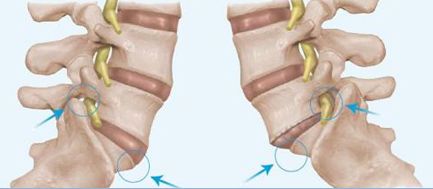The causes of development, symptoms, diagnosis of spondylolisthesis of the cervical spine
Spondylolisthesis of the cervical spine – the offset of an overlying vertebra in relation to the underlying analogue in the cervical spine. Listed can be directed forward or backward (retro - and antispeciesist).
The Consequence of displacement is the deformation of the spine, neurological symptoms, pain, and foraminal stenosis (pinching of the nerve root emerging from the spinal cord).

How is pathology
Spondylolisthesis in the neck is most often localized at the level of 4 or fifth vertebrae (C4, C5). The main cause of the disease is considered spondylolysis – splitting shackle legs vertebra. Leg is education, which captures the body of the vertebra and the facet joints.
In practice, doctors very often there are cases when the displacement of the vertebrae occurs due to a fracture in early childhood. With the first signs of pathology are observed only in adulthood, when forming a strong physical load on the shoulder girdle (when lifting).
Feature of the splitting of the vertebral arches in the neck is that the process occurs slowly over several years. Progressive offset makes it difficult to timely diagnosis when performing radiography.
Thus, fractured vertebrae, received in childhood, can disturb after reaching 35 years of age. In young people it is observed only as a consequence of traumatic injuries of the spine, and in elderly – degenerative-dystrophic processes. There is also a genetic predisposition to the disease.
Symptoms

Spondylolisthesis of the cervical spine is manifested by symptoms of instability. They are formed on the background:
- increase the range of motion in the spine;
- violations of the relationship between the individual vertebrae
- Strain and pathologic soft tissue destruction;
- Limitation of motion due to degenerative disc disease, spondylosis, scoliosis.
And There are predisposing factors to increased mobility of the vertebral segments in the neck:
- Age-related degeneration of the musculoskeletal system;
- Rarefaction of bone structure (osteoporosis)
- degenerative disc disease at the level of C1-C2.
The First symptom is pain. The pain may be dull or sharp. In the first case it is caused by reflex neck muscle tension, while the second increased tone of paravertebral muscles.
In the muscle tissue occur circulatory disorders, which are characterized by reduced muscle tone. Consequently the person who for a long period of time is in the upright position, fatigue occurs quickly. Over time there is a need to support their heads with their arms.
Neurological
Spondylolisthesis of the cervical part of the vertebral column is almost always accompanied by neurological manifestations. Among them are the following symptoms:
- Radicular – cervicalgia, backache;
- Neurodystrophic syndrome of the anterior scalene muscle, shoulder, cardiac pain, compression of vertebral artery
- Spinal – anterior - and posterior threshold, sadashivaiah, conductor.
Cervicalgia not characterized by severe pain (in comparison with the cervical). They appear periodic aching in the neck radiating to the temporal or occipital area of the head.
Periarthritis syndrome of anterior scalene muscle accompanied by pain in the shoulder joint when attempting to move or lift a weight.
Spinal syndrome is a serious complication of the disease, which often leads to disability due to compression of the spinal cord and conduction abnormalities along the nerve fibers.
When assessing the severity of neurologic manifestations with cervical spondylolisthesis doctors allocate 4 degree of severity of the disease:
- stage 1 – rare pain in the neck, which occur at sharp turns of the head or lifting weights
- stage 2 – displacement of the vertebrae characterized by severe pain and discomfort when moving;
- stage 3 – symptoms are worse on the background of reducing the length of the cervical spine ("sinking" of the intervertebral discs);
- stage 4 – there are marked pain in the cervical spine and head.
Radiology diagnostic
normal on radiographs of the cervical part of the vertebral column the vertebrae to one another form a correct arc. What is observed on radiographs in spondylolisthesis:
- Lost the smooth contours lordosis (convexity of the axis medially);
- the Appearance stylebrand borders of the vertebrae;
- is Lost parallelism of the articular surfaces of the intervertebral joints;
- On functional radiographs (at maximum flexion and extension of the neck) is observedperiodic protrusion of the separate vertebrae;
- reduced the height of the front and rear disc;
- Convergence of the endplates of the vertebral bodies;
- in atlantoaxial Subluxation of the joint is determined on the basis of roentgenometry in frontal and lateral projections.
Pronounced spondylolisthesis leads to dysfunction of the upper extremities.
Are particularly vulnerable to complications of the disease, which can lead to numbness of the skin, the breathing and circulation. To treat such complications of cardiac drugs is not effective, as they are caused by pinching of the nerve root or spinal cord compression.
Thus, cervical spondylolisthesis without effective treatment slowly but surely causes the neurological manifestations with which to cope people.













